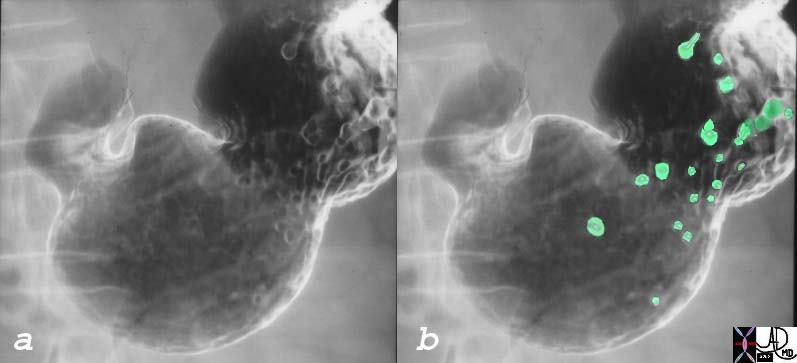The Common Vein Copyright 2008
Definition
Cronkhite-Canada Syndrome is a rare non familial syndrome of the gastrointestinal tract and epidermis, that has a predisposition for people of Japanese descent and is characterized by hamartomatous epithelial proliferation in GI tract associated with changes in the epidermis including epidermis such as hyperpigmentation, alopecia, and onychodystrophy. Other characteristic features include loss of taste and instances of spontaneous remission. The esophagus is usually spared.
The cause of the disease is mostly unknown but stress and fatigue have been hypothesized.
The resulting epithelial changes in the GI tract, show hamartomatous proliferation as well as edema and congestion of intervening mucosa. The clinical syndrome includes diarrhea associated with malabsorbtion, protein losing eneteropathy, and fluid and electrolyte disturbances, with skin and nail disorders described above.
Complications include malnutrition and about 10% of patients show malignant transformation.
The diagnosis is suspected clinically by the clinical history of diarrhea, abdominal pain weight loss, alopecia and onychodystrophy. Imaging includes the use of endoscopy where polyps can be identified in the stomach, small bowel and colon. Biopsy confirms the hamartomatous nature of the polyps, which are of the juvenile type. The mucosa and lamina propria are usually edematous, with tortuous and mucus filled glands. Adenomatous change and carcinoma may be seen in some of the polyps.
The polyps can also be identified by barium studies, and are best seen with air contrast technique.
Treatment is usually supportive and includes fluid and electrolyte replacement, hyperalimentation, antibiotics and steroids, with surgery reserved for intervening complications.
 Gastric Hamartomas in Patient with Canada-Cronkhite Syndrome Gastric Hamartomas in Patient with Canada-Cronkhite Syndrome |
| 01356c02 stomach gastric polyps hamartomatous Cronkhite-Canada syndrome Canada-Cronkhite syndrome upper GI UGI imaging radiology contrast X-Ray Courtesy Ashley Davidoff MD |
DOMElement Object
(
[schemaTypeInfo] =>
[tagName] => table
[firstElementChild] => (object value omitted)
[lastElementChild] => (object value omitted)
[childElementCount] => 1
[previousElementSibling] => (object value omitted)
[nextElementSibling] =>
[nodeName] => table
[nodeValue] =>
Gastric Hamartomas in Patient with Canada-Cronkhite Syndrome
01356c02 stomach gastric polyps hamartomatous Cronkhite-Canada syndrome Canada-Cronkhite syndrome upper GI UGI imaging radiology contrast X-Ray Courtesy Ashley Davidoff MD
[nodeType] => 1
[parentNode] => (object value omitted)
[childNodes] => (object value omitted)
[firstChild] => (object value omitted)
[lastChild] => (object value omitted)
[previousSibling] => (object value omitted)
[nextSibling] => (object value omitted)
[attributes] => (object value omitted)
[ownerDocument] => (object value omitted)
[namespaceURI] =>
[prefix] =>
[localName] => table
[baseURI] =>
[textContent] =>
Gastric Hamartomas in Patient with Canada-Cronkhite Syndrome
01356c02 stomach gastric polyps hamartomatous Cronkhite-Canada syndrome Canada-Cronkhite syndrome upper GI UGI imaging radiology contrast X-Ray Courtesy Ashley Davidoff MD
)
DOMElement Object
(
[schemaTypeInfo] =>
[tagName] => td
[firstElementChild] =>
[lastElementChild] =>
[childElementCount] => 0
[previousElementSibling] =>
[nextElementSibling] =>
[nodeName] => td
[nodeValue] => 01356c02 stomach gastric polyps hamartomatous Cronkhite-Canada syndrome Canada-Cronkhite syndrome upper GI UGI imaging radiology contrast X-Ray Courtesy Ashley Davidoff MD
[nodeType] => 1
[parentNode] => (object value omitted)
[childNodes] => (object value omitted)
[firstChild] => (object value omitted)
[lastChild] => (object value omitted)
[previousSibling] => (object value omitted)
[nextSibling] => (object value omitted)
[attributes] => (object value omitted)
[ownerDocument] => (object value omitted)
[namespaceURI] =>
[prefix] =>
[localName] => td
[baseURI] =>
[textContent] => 01356c02 stomach gastric polyps hamartomatous Cronkhite-Canada syndrome Canada-Cronkhite syndrome upper GI UGI imaging radiology contrast X-Ray Courtesy Ashley Davidoff MD
)
DOMElement Object
(
[schemaTypeInfo] =>
[tagName] => td
[firstElementChild] => (object value omitted)
[lastElementChild] => (object value omitted)
[childElementCount] => 1
[previousElementSibling] =>
[nextElementSibling] =>
[nodeName] => td
[nodeValue] => Gastric Hamartomas in Patient with Canada-Cronkhite Syndrome
[nodeType] => 1
[parentNode] => (object value omitted)
[childNodes] => (object value omitted)
[firstChild] => (object value omitted)
[lastChild] => (object value omitted)
[previousSibling] => (object value omitted)
[nextSibling] => (object value omitted)
[attributes] => (object value omitted)
[ownerDocument] => (object value omitted)
[namespaceURI] =>
[prefix] =>
[localName] => td
[baseURI] =>
[textContent] => Gastric Hamartomas in Patient with Canada-Cronkhite Syndrome
)

